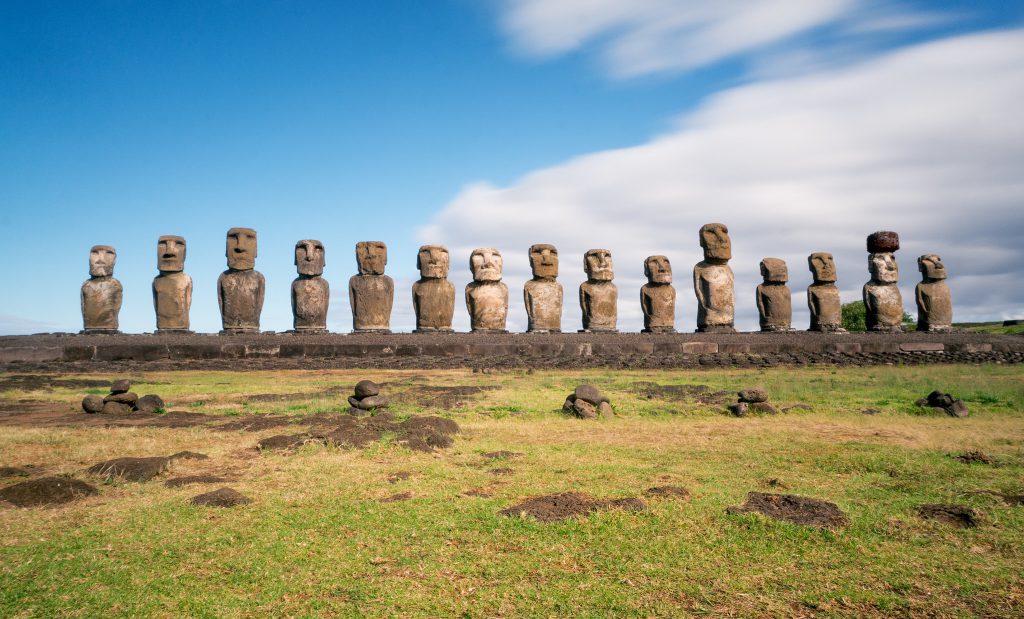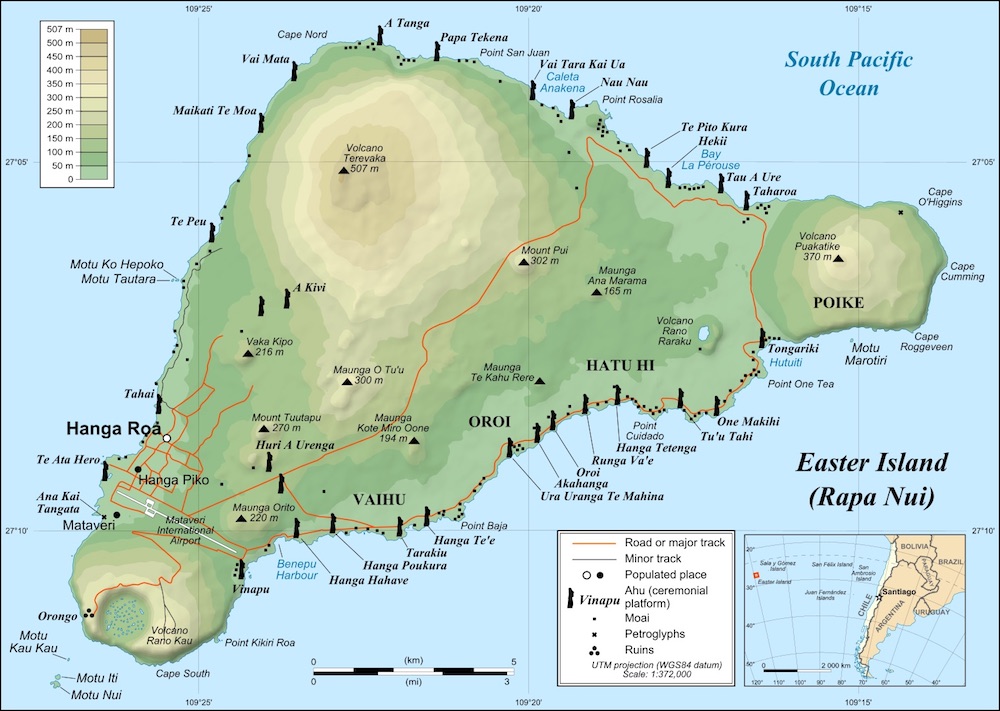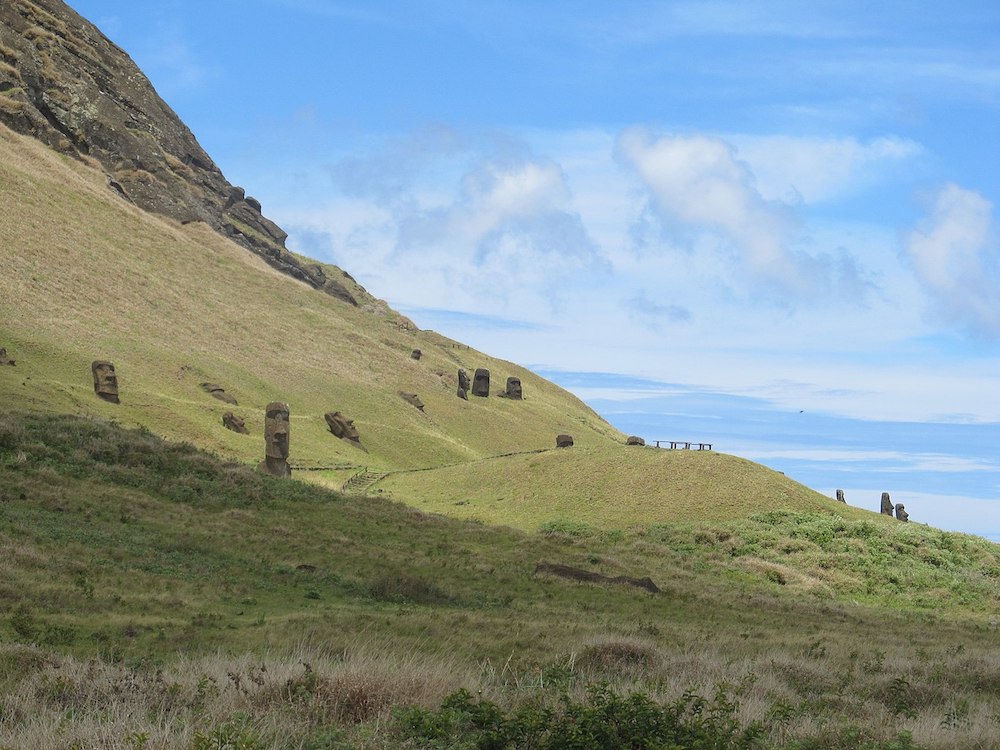Rethinking Easter Island’s Historic “Collapse”

Easter Island’s colossal statues loom large—both literally and figuratively—in the popular imagination. The massive heads and torsos dot the landscape like stone sentinels, standing guard over the isle’s treeless, grassy expanse.
The statues have inspired widespread speculation, awe, and wonder for centuries. But the island, called Rapa Nui by its Indigenous people, has also captured the world’s imagination for an entirely different reason.
Rapa Nui is often seen as a cautionary example of societal collapse. In this story, made popular by geographer Jared Diamond’s bestselling book Collapse, the Indigenous people of the island, the Rapanui, so destroyed their environment that, by around 1600, their society fell into a downward spiral of warfare, cannibalism, and population decline. These catastrophes, the collapse narrative explains, resulted in the destruction of the social and political structures that were in place during precolonial times, though the people of Rapa Nui survive and persist on the island to the present day.
In recent years, researchers working on the island have questioned this long-accepted story. For example, anthropologist Terry Hunt and archaeologist Carl Lipo, who have studied the island’s archaeology and cultural history for many years, have suggested an alternative hypothesis that the Rapanui did not succumb to a downward spiral of self-destruction but instead practiced resiliency, cooperation, and perhaps even a degree of environmental stewardship.
Now new evidence from Hunt, Lipo, and their colleagues, published in the Journal of Archaeological Science, lends credence to their ideas. This evidence suggests that the people of the island continued to thrive, as indicated by the continued construction of the stone platforms, called ahu, on which the iconic statues stand, even after the 1600s.
“Our research shows that statue platform construction and use did not end prior to European arrival in 1722,” says Robert DiNapoli, a doctoral student in anthropology at the University of Oregon, who led the study.
This finding, drawing on new statistical methods and excavation work, suggests that the Rapanui were not destitute when the first Europeans arrived. It’s therefore possible that it was the newcomers from Europe who contributed to the island’s societal collapse in the years to come.
The new work is controversial, and not everyone is convinced. But if DiNapoli and his team are correct, the popular story of Rapa Nui’s decline, as described by Diamond, needs to be rethought and its heroes and villains reconfigured. Instead of the Rapanui hastening their own destruction prior to European contact, it is possible that the people of the island may have been the victims of European exploration and exploitation.
Rapa Nui is one of the most remote islands in the world. A tiny speck in the eastern Pacific, it sits more than 2,000 miles west of South America and is about 1,200 miles from its nearest island neighbor, Pitcairn Island.
Archaeologists have documented at least 360 ahu, most of which cluster along the island’s shoreline. They vary in configuration, though most are typically rectangular in shape and are made of basaltic stones neatly fitted together. In addition to their use as statue platforms, the ahu functioned as shrines and places of burial.
DiNapoli and his colleagues used existing radiocarbon dates from previous excavations at 11 different ahu sites. They employed what is called Bayesian analyses, which allow scientists to model the probability of specific events, to build a more precise timeline of construction activities at each site.
The new research indicates that ahu construction began soon after the first Polynesian settlers arrived on the island and continued even after European contact in 1722. This timeline argues against the hypothesized societal collapse occurring around 1600.
The downturn of the islanders, DiNapoli and his colleagues claim, began only after Europeans ushered in a period characterized by disease, murder, slave raiding, and other conflicts.
Not all Rapa Nui specialists agree with DiNapoli and his colleagues’ methods or conclusions. Jo Anne Van Tilburg, an archaeologist at the University of California, Los Angeles, is skeptical that all the radiocarbon dates used by the team reflect specifically ahu-related building events.
Van Tilburg also argues that Diamond’s environmental destruction argument remains a viable hypothesis. “The collapse narrative as these authors describe it is a straw man they have set up that does not accurately reflect the actual hypothesis,” she says.
If Europeans were to blame for the decline of Rapanui society, it would be similar to what happened to Indigenous peoples elsewhere.
In short, Van Tilburg believes the new work is missing some of the nuances of Diamond’s original theory. Diamond never described the collapse as a one-time event, Van Tilburg explains, but rather as a series of events that ultimately resulted in destructive societal changes that were hastened by European contact.
Diamond’s hypothesis is based on a mix of oral tradition, evidence of island deforestation, and the work of previous researchers, such as the Norwegian explorer and ethnologist Thor Heyerdahl. (Heyerdahl gained fame in 1947 for sailing a balsa raft, the Kon-Tiki, to test the theory that South Americans may have colonized Polynesia.)
Early 20th-century oral historians working on Rapa Nui theorized that an internecine clash had occurred between islanders. Heyerdahl later popularized his belief that this warfare, combined with deforestation, resulted in the collapse of the island’s social hierarchies and many traditions, such as the building of stone platforms and statues.
The fate of Rapa Nui has been heatedly debated over the last several years with the development of new theories and innovative techniques, such as Bayesian methods. For many archaeologists, the pre-contact collapse theory is ripe for questioning.
Speaking of the research conducted by DiNapoli’s team, for example, Seth Quintus, an anthropologist at the University of Hawaiʻi, Mānoa, who was not involved in the study, says, “Their work adds to the growing body of evidence that has accumulated over the last 10 years that the previous narratives of collapse on Easter Island are not correct—and need to be rethought.”
If Europeans were to blame for the decline of Rapanui society, that explanation is similar to what happened to other Indigenous peoples elsewhere throughout the world, DiNapoli notes. From that perspective, he says, the popular story of environmental destruction has obscured the islanders’ successes.
“The degree to which their cultural heritage was passed on—and is still present today through language, arts, and cultural practices—is quite notable and impressive,” DiNapoli says. “This degree of resilience has been overlooked due to the collapse narrative and deserves recognition.”

































